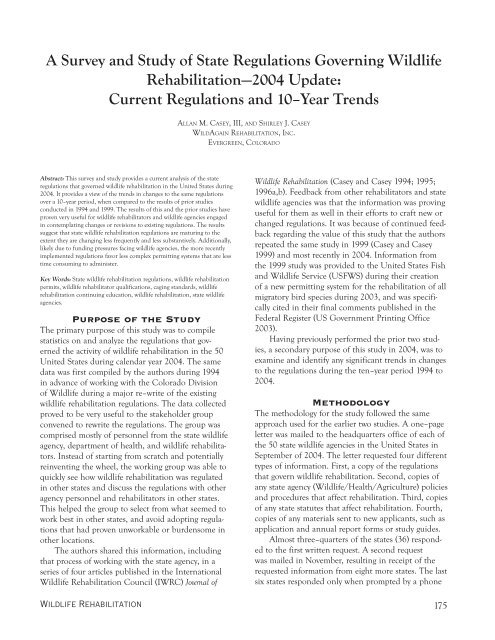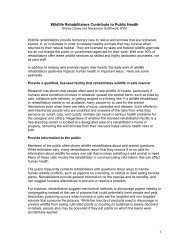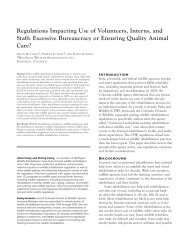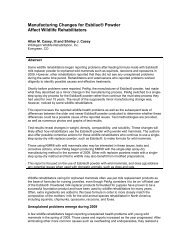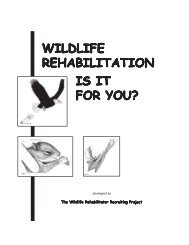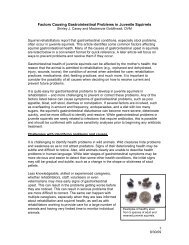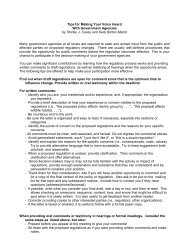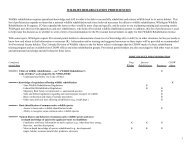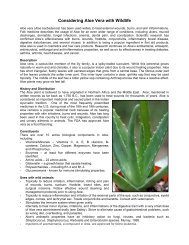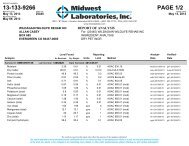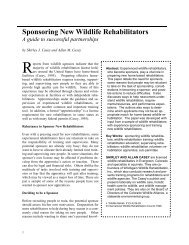1994 - WildAgain Wildlife Rehabilitation
1994 - WildAgain Wildlife Rehabilitation
1994 - WildAgain Wildlife Rehabilitation
Create successful ePaper yourself
Turn your PDF publications into a flip-book with our unique Google optimized e-Paper software.
A Survey and Study of State Regulations Governing <strong>Wildlife</strong><br />
<strong>Rehabilitation</strong>—2004 Update:<br />
Current Regulations and 10–Year Trends<br />
ALLAN M. CASEY, III, AND SHIRLEY J. CASEY<br />
WILDAGAIN REHABILITATION, INC.<br />
EVERGREEN, COLORADO<br />
Abstract: This survey and study provides a current analysis of the state<br />
regulations that governed wildlife rehabilitation in the United States during<br />
2004. It provides a view of the trends in changes to the same regulations<br />
over a 10–year period, when compared to the results of prior studies<br />
conducted in <strong>1994</strong> and 1999. The results of this and the prior studies have<br />
proven very useful for wildlife rehabilitators and wildlife agencies engaged<br />
in contemplating changes or revisions to existing regulations. The results<br />
suggest that state wildlife rehabilitation regulations are maturing to the<br />
extent they are changing less frequently and less substantively. Additionally,<br />
likely due to funding pressures facing wildlife agencies, the more recently<br />
implemented regulations favor less complex permitting systems that are less<br />
time consuming to administer.<br />
Key Words: State wildlife rehabilitation regulations, wildlife rehabilitation<br />
permits, wildlife rehabilitator qualifications, caging standards, wildlife<br />
rehabilitation continuing education, wildlife rehabilitation, state wildlife<br />
agencies.<br />
Purpose of the Study<br />
The primary purpose of this study was to compile<br />
statistics on and analyze the regulations that governed<br />
the activity of wildlife rehabilitation in the 50<br />
United States during calendar year 2004. The same<br />
data was first compiled by the authors during <strong>1994</strong><br />
in advance of working with the Colorado Division<br />
of <strong>Wildlife</strong> during a major re–write of the existing<br />
wildlife rehabilitation regulations. The data collected<br />
proved to be very useful to the stakeholder group<br />
convened to rewrite the regulations. The group was<br />
comprised mostly of personnel from the state wildlife<br />
agency, department of health, and wildlife rehabilitators.<br />
Instead of starting from scratch and potentially<br />
reinventing the wheel, the working group was able to<br />
quickly see how wildlife rehabilitation was regulated<br />
in other states and discuss the regulations with other<br />
agency personnel and rehabilitators in other states.<br />
This helped the group to select from what seemed to<br />
work best in other states, and avoid adopting regulations<br />
that had proven unworkable or burdensome in<br />
other locations.<br />
The authors shared this information, including<br />
that process of working with the state agency, in a<br />
series of four articles published in the International<br />
<strong>Wildlife</strong> <strong>Rehabilitation</strong> Council (IWRC) Journal of<br />
<strong>Wildlife</strong> <strong>Rehabilitation</strong><br />
<strong>Wildlife</strong> <strong>Rehabilitation</strong> (Casey and Casey <strong>1994</strong>; 1995;<br />
1996a,b). Feedback from other rehabilitators and state<br />
wildlife agencies was that the information was proving<br />
useful for them as well in their efforts to craft new or<br />
changed regulations. It was because of continued feedback<br />
regarding the value of this study that the authors<br />
repeated the same study in 1999 (Casey and Casey<br />
1999) and most recently in 2004. Information from<br />
the 1999 study was provided to the United States Fish<br />
and <strong>Wildlife</strong> Service (USFWS) during their creation<br />
of a new permitting system for the rehabilitation of all<br />
migratory bird species during 2003, and was specifically<br />
cited in their final comments published in the<br />
Federal Register (US Government Printing Office<br />
2003).<br />
Having previously performed the prior two studies,<br />
a secondary purpose of this study in 2004, was to<br />
examine and identify any significant trends in changes<br />
to the regulations during the ten–year period <strong>1994</strong> to<br />
2004.<br />
Methodology<br />
The methodology for the study followed the same<br />
approach used for the earlier two studies. A one–page<br />
letter was mailed to the headquarters office of each of<br />
the 50 state wildlife agencies in the United States in<br />
September of 2004. The letter requested four different<br />
types of information. First, a copy of the regulations<br />
that govern wildlife rehabilitation. Second, copies of<br />
any state agency (<strong>Wildlife</strong>/Health/Agriculture) policies<br />
and procedures that affect rehabilitation. Third, copies<br />
of any state statutes that affect rehabilitation. Fourth,<br />
copies of any materials sent to new applicants, such as<br />
application and annual report forms or study guides.<br />
Almost three–quarters of the states (36) responded<br />
to the first written request. A second request<br />
was mailed in November, resulting in receipt of the<br />
requested information from eight more states. The last<br />
six states responded only when prompted by a phone<br />
175
176 Volume 23, Minneapolis, MN, 2005<br />
Table 1. <strong>Wildlife</strong> Possession Restrictions.<br />
2004 1999 <strong>1994</strong><br />
Regs prohibit private possession 50 50 50<br />
Temporary possession OK for rehab. 46 45 42<br />
Temporary possession OK for rescuers 3 3 0<br />
Table 2. <strong>Rehabilitation</strong> Permit Regulations.<br />
Table 3. Levels or Categories of Permits.<br />
2004 1999 <strong>1994</strong><br />
Regulations are specific to rehab. 39 33 31<br />
Permits are specific to rehabilitation 45 40 38<br />
Permit fee (or can be assessed) 12 9 5<br />
Permit duration<br />
One year 29 27 27<br />
Greater than one year 16 14 14<br />
2004 1999 <strong>1994</strong><br />
Single category 28 31 29<br />
2 (provides for an apprentice class) 9 6 9<br />
3 categories 5 5 4<br />
4 categories 3 3 0<br />
Table 4. Personal Qualifications.<br />
Experience requirements<br />
2004 1999 <strong>1994</strong><br />
“Knowledge & proficiency” 24 22 18<br />
Minimum experience (mo. or yrs.) 15 11 3<br />
Apprenticeship<br />
6 months or less 4 3 3<br />
12 months or more 12 9 5<br />
Pass a test (score > 80%) 16 15 10<br />
Age<br />
At least 18 years of age 20 13 6<br />
Less than 18 years of age 1 2 2<br />
References<br />
Assisting veterinarian 35 29 23<br />
From another rehabilitator 16 12 8<br />
General character reference 11 11 10<br />
call in February 2005. Information was used in the<br />
study as received and when received.<br />
As in the prior two studies, the primary areas of<br />
analysis included the same 10 subject areas, including:<br />
– Type of permit and general conditions<br />
– Personal qualifications (experience, testing,<br />
etc.)<br />
– Caging (requirements, approvals)<br />
– Inspections (facilities and records, notice)<br />
– Annual report (format, content, due date)<br />
– Recordkeeping (format, content)<br />
– Release (maximum holding time, location)<br />
– Restricted and prohibited species (Rabies<br />
Vector Species [RVS], Threatened and<br />
Endangered species [T&E])<br />
– Application form (form, content)<br />
– Incoming animal requirements<br />
(examination by a veterinarian, etc.)<br />
The included set of tables indicates<br />
various aspects of the regulations and the<br />
number of states that had such a requirement<br />
in each of the three study periods.<br />
Permit Types and General<br />
Conditions<br />
All 50 states have a general prohibition on any<br />
type of private possession of native wildlife<br />
(Table 1). A permit, license, or other authorization<br />
is required to even temporarily possess<br />
wild animals for the purpose of rehabilitation.<br />
All but four states currently allow for some<br />
form of wildlife rehabilitation. Some states,<br />
recognizing that a well–meaning rescuer is<br />
technically in violation of this private possession<br />
prohibition, now allow the temporary<br />
possession by the public but only for purposes<br />
of rescue and immediate transport to a rehabilitator.<br />
While there are 46 states that allow for<br />
wildlife rehabilitation to be performed by permitted<br />
or licensed individuals, only 39 states<br />
have regulations that are specific to rehabilitation<br />
(Table 2). The other states allow for the<br />
activity under some other type of permit or<br />
agency authorization or supervision. Since<br />
<strong>1994</strong>, the number of states that now have<br />
or can charge a fee associated with issuance<br />
of the permit has doubled. Approximately<br />
two–thirds of the permits issued are for the<br />
period of one year, the rest are issued for time<br />
periods longer than a year.<br />
While most states (56%) only issue one level of<br />
permit, about one–third of the states issue multiple<br />
levels of permits, generally associated with experience<br />
levels or for those activities that require special procedures<br />
or training, such as rehabilitating rabies vector
<strong>Wildlife</strong> <strong>Rehabilitation</strong><br />
177<br />
species. As shown in Table 2, the category that<br />
experienced an increase in the last five years is<br />
that of two levels of permit. This is generally a<br />
standard or full permit, as well as a permit for<br />
an apprentice or sub–permittee.<br />
Personal Qualifications<br />
The most significant changes in personal<br />
qualifications required to receive a permit deal<br />
with minimum experience and age requirements.<br />
While about half of the states (48%)<br />
require general “knowledge and proficiency,”<br />
15 states, a five–fold increase over <strong>1994</strong>, now<br />
require a minimum amount of experience<br />
as measured in time of months or years.<br />
Additionally, there has been a doubling of the<br />
states that now require a formal apprenticeship<br />
period under the supervision of another<br />
rehabilitator, ranging from as short as six<br />
months, but is generally 12 months, or longer<br />
in some states. Approximately one–third of<br />
the states now require successful passage of a<br />
written test (usually with a score of 80 percent<br />
or better), as shown in Table 4. However,<br />
only one state added this requirement in<br />
the last five years. Almost half of the states<br />
now require the permit holder to be at least<br />
18 years of age. Lastly, a reference is usually<br />
required from a veterinarian, with about one–<br />
third of the states also requiring a reference<br />
from another rehabilitator.<br />
Permit Renewal<br />
Most states (76%) require the completion and<br />
submission of an annual report in order to<br />
renew the permit for the next year. Almost<br />
one–third also now require a separate renewal<br />
application as well. As shown in Table 5, there<br />
has been a doubling in the last ten years in<br />
the number of states that require some form<br />
of continuing education in order to renew a<br />
permit. Some require evidence of continuing<br />
education activities each year, while others<br />
only require it over a period of years. Some<br />
states must approve the training in order to<br />
qualify, while most states leave the selection<br />
of the training activity to the individual<br />
rehabilitator.<br />
Table 5. Permit Renewal Requirements.<br />
2004 1999 <strong>1994</strong><br />
Submit annual report 38 34 30<br />
Submit renewal application 13 13 9<br />
Continuing education<br />
Each year 5 4 3<br />
Every 2 to 3 years 7 4 2<br />
Required, but not specific 4 3 2<br />
Table 6. New Emerging Permit Provisions.<br />
2004 1999 <strong>1994</strong><br />
Use of (unpermitted) volunteers OK 21 16 9<br />
Must not conflict with local ordinances 18 11 *<br />
Agency not responsible for costs 16 16 *<br />
Can’t charge the public (donations OK) 14 10 *<br />
<strong>Wildlife</strong> remains property of the state 12 10 *<br />
Permit issued based on need 12 9 *<br />
Does not auth. practice of vet medicine 11 8 *<br />
* Not tabulated in the <strong>1994</strong> study.<br />
Table 7. Caging Requirements.<br />
Specificity in regulation<br />
2004 1999 <strong>1994</strong><br />
General in nature 31 35 28<br />
Specific requirements 18 13 9<br />
NWRA/IWRC Minimum Standards 19 13 3<br />
Cages required for all ages 17 14 12<br />
No public display or contact 29 21 10<br />
Table 8. Inspections.<br />
2004 1999 <strong>1994</strong><br />
Required for initial permit issuance 46 44 37<br />
Timing or notice required<br />
“at reasonable times” 22 19 15<br />
Normal business hours 5 4 4<br />
Immediate 5 6 5<br />
Not specified 17 19 16<br />
May be unannounced 6 6 6<br />
New and Emerging General<br />
Permit Provisions<br />
The data contained in Table 6 indicates some of the<br />
emerging provisions and conditions that state wildlife<br />
agencies have begun to include in the last five years.<br />
Some of these provisions are fairly obvious and unob-
178 Volume 23, Minneapolis, MN, 2005<br />
Table 9. Annual Report—Requirements.<br />
2004 1999 <strong>1994</strong><br />
Specific format specified 36 32 27<br />
Contents<br />
List each animal 41 41 36<br />
Source or cause 21 19 14<br />
Date in 36 32 24<br />
Date out 35 32 26<br />
Disposition 43 40 34<br />
Release location 8<br />
Table 10. Annual Report—Due–Date.<br />
2004 1999 <strong>1994</strong><br />
Monthly 1 1 1<br />
Quarterly 1<br />
Semi-annually 1 1 1<br />
Dec 31 8 9 6<br />
Jan 10 - 20 6 7 5<br />
Jan 30 - 31 24 19 17<br />
Feb 01 2 3 2<br />
Jul 15 1<br />
Table 11. Recordkeeping.<br />
2004 1999 <strong>1994</strong><br />
Format specified 17 15 13<br />
Timeliness<br />
Current / up-to-date 12 11 9<br />
Daily / within 24 hours 6 5 4<br />
Available for inspection<br />
Yes (not specific) 16 14 11<br />
At reasonable times 16 16 14<br />
Maintain for:<br />
1 year 1 1 1<br />
2 years 3 2 0<br />
3 years 2 2 0<br />
5 years 4 2 2<br />
trusive, such as the permit does not authorize the practice<br />
of veterinary medicine; wildlife undergoing rehabilitation<br />
always remains property of the state; and the<br />
agency is not responsible for any costs associated with<br />
rehabilitation activities.<br />
Other of the provisions listed can be more challenging<br />
in obtaining a permit, such as the permit must<br />
not conflict with any local ordinance. This<br />
may require the permit applicant to first work<br />
with the local planning and zoning officials<br />
to change local regulations to allow for the<br />
temporary housing of wild animals within city<br />
limits. Another is that permits may be issued<br />
based upon need as assessed by the agency.<br />
This could also serve as a barrier for a new<br />
applicant based on the agency’s sole and arbitrary<br />
determination that it believes there are<br />
“too many” or “enough” rehabilitators in a<br />
given area.<br />
Caging and Inspection<br />
Requirements<br />
All of the states that allow wildlife rehabilitation<br />
activities require that an initial cage<br />
inspection be conducted by the agency or its<br />
representative. The inspection is generally<br />
conducted after the application has been submitted<br />
and is conducted by the local wildlife<br />
officer. Many states (62%) only have very<br />
general requirements for caging in the regulations,<br />
while more states (doubling since <strong>1994</strong>)<br />
have adopted very specific requirements and<br />
criteria. Over one–third of the states refer to<br />
the caging guidelines as contained in one or<br />
more editions of the NWRA/IWRC Minimum<br />
Standards for <strong>Wildlife</strong> <strong>Rehabilitation</strong> document<br />
(Minimum Standards) (White 1988; Miller and<br />
White 1993; Miller 2000). As shown in Table<br />
7, about one–third of the states require caging<br />
suitable for all ages of the animals in rehabilitation,<br />
while over half now require no public<br />
display of rehabilitation animals or contact<br />
with domestic animals.<br />
As shown in Table 8, inspections generally<br />
require some amount of prior notice to<br />
be provided by the agency to the rehabilitator.<br />
Most of the inspections are conducted during<br />
reasonable times or normal business hours,<br />
however some state regulations stipulate that<br />
the inspections can be either immediate or<br />
unannounced.<br />
Annual Report<br />
Most of the states specify the format for the required<br />
annual report. Most states specify the same data items<br />
to be included in the report. As shown in Table 9,<br />
most require that the permit holder report the receipt<br />
of each animal on an individual basis, as well as date<br />
in, date out, and disposition. A little less than half of
<strong>Wildlife</strong> <strong>Rehabilitation</strong><br />
179<br />
the states require reporting of the source or<br />
reason the animal was admitted to rehabilitation.<br />
In this study, eight states now require<br />
that the release location be reported for each<br />
animal.<br />
The due–date for the annual report varies<br />
as to frequency and date among the states. As<br />
shown in Table 10, some states require reporting<br />
on a monthly, quarterly, or semi–annual<br />
basis. For those that only require an annual<br />
submission of activity, the due dates fall at the<br />
end of the year, between December 31 and<br />
February 1. One state requires the report on<br />
July 15, right in the middle of most rehabilitators’<br />
busiest time of year.<br />
Recordkeeping<br />
While most states require a periodic report,<br />
only about one–third of the states specify<br />
a format for the ongoing maintenance of<br />
records and logs. As shown in Table 11, some<br />
states have requirements as to keeping the<br />
records up–to–date, sometimes daily; availability<br />
for inspection by the agency; and the<br />
period of time the records must be kept by the<br />
permit holder, in some cases up to five years.<br />
Release of Animals and<br />
Non-releaseables<br />
Twenty states have consistently maintained<br />
approval authority over release location during<br />
the 10–year study period. As shown in Table<br />
12, the states have become much more interested in<br />
stipulating in regulation that the animals be released<br />
in the vicinity of the capture point or no more than<br />
five to ten miles from the original capture point.<br />
Additionally, a few of the regulations now require that<br />
the rehabilitator obtain landowner permission prior to<br />
release on any privately owned land.<br />
In addition to specifying location requirements,<br />
many states have specified maximum time limits on<br />
holding an animal prior to final disposition. As shown<br />
in Table 13, 10 states require release as soon as possible.<br />
Another 21 states specify maximum holding<br />
times ranging from 30 days up to one year, with most<br />
specifying 180 days. Fifteen states do not specify a<br />
time limit, leaving time in captivity and final release to<br />
the judgment and discretion of the rehabilitator.<br />
Because of the prohibition on private possession<br />
of native wild animals, most states do not allow rehabilitators<br />
to keep indefinitely those animals that may<br />
have recovered from injury or disease, but for one or<br />
Table 12. Release of Animals—Location.<br />
2004 1999 <strong>1994</strong><br />
As designated by the agency 20 20 20<br />
In vicinity of capture point 14 12 7<br />
Within 5-10 miles of capture point 3 3 2<br />
Requires landowner permission 3 0 0<br />
Table 13. Release of Animals—Maximum Holding Time.<br />
2004 1999 <strong>1994</strong><br />
None specified 15 18 17<br />
“…ASAP…” 10 13 10<br />
Max. days 30 1 1 1<br />
60 2 2 3<br />
90 5 5 2<br />
120 1 1 1<br />
180 10 4 3<br />
365 2 1 1<br />
Table 14. Options for Non–releaseables.<br />
2004 1999 <strong>1994</strong><br />
Use as an educational animal 27 24<br />
Scientific research use or breeding 14 14<br />
Placed with a zoo 12 11<br />
Beneficial use in rehab (fostering) 6 6 6<br />
} 23<br />
more reasons are unreleaseable to the wild. However,<br />
as shown in Table 14, some states do allow for these<br />
animals to be kept in captivity, generally for use as an<br />
educational program animal, but also, in some cases,<br />
for scientific or breeding purposes; placed with an<br />
accredited zoo; and kept by the rehabilitator for beneficial<br />
use in the rehabilitation process, such as fostering<br />
orphan animals.<br />
Restricted and Prohibited<br />
Species<br />
The restrictions and prohibitions placed by the wildlife<br />
agency on the rehabilitation of certain species are<br />
always contentious issues with wildlife rehabilitators.<br />
A restriction generally allows for rehabilitation of a species,<br />
but requires that certain conditions be met by<br />
the rehabilitator. These conditions can include such<br />
things as receiving special training, following specified<br />
safety procedures, or release of animals only in certain<br />
pre–determined locations. At least if the restrictions<br />
are satisfied and complied with, these animals can be<br />
rehabilitated in accordance with the regulations.
180 Volume 23, Minneapolis, MN, 2005<br />
Table 15. <strong>Wildlife</strong> Possession Restrictions.<br />
A prohibition placed on a species usually means<br />
that the animal cannot be rehabilitated under any<br />
circumstances. In many situations, a study of rehabilitator<br />
behavior as well as anecdotal evidence suggest<br />
that this just pushes the rehabilitation activity underground,<br />
outside of the permit and regulations and<br />
agency oversight (Siemer and Brown 1992).<br />
As shown in Table 15, at least for RVS, while state<br />
Restricted<br />
2004 1999 <strong>1994</strong> 2004 1999 <strong>1994</strong><br />
Rabies Vector Species<br />
Raccoon 15 10 5 5 6 3<br />
Skunk 13 9 6 6 7 4<br />
Fox 11 8 6 4 5 2<br />
Bat 9 5 3 3 3 1<br />
Coyote 6 4 1 3 3 1<br />
Bobcat 6 5 5 1 2<br />
Woodchuck 4 3 1 1 1 1<br />
Adult RVS 2 2<br />
Opossum 1 1<br />
Game Animals<br />
Deer 15 13 5 2 2 1<br />
Black Bear 8 6 5 4 2 1<br />
Moose 4 4 4 1 1 1<br />
Elk 3 2 1 2<br />
Mtn. Lion 3 1 1 2<br />
Big game 1 2 2 1 1 1<br />
Any game 1 1 1<br />
Other game species 1 1 1<br />
Threat. & Endangered<br />
Approval required 7 7 5 * * *<br />
Notification<br />
24 hours 10 4 6<br />
48 hours 5 3 2<br />
72 hours 2 2 1<br />
Other Concerns<br />
Environmental 1 1 3 2 1<br />
“Dangerous” 3 1 1<br />
All mammals 4 3 1<br />
Orphans 1 1 1<br />
*T&E species generally prohibited for an apprentice or sub-permittee<br />
wildlife agencies seem<br />
appropriately concerned<br />
Prohibited<br />
about rehabilitation of<br />
RVS, they prefer to allow<br />
the activity, but with<br />
restrictions aimed at protecting<br />
human health and<br />
safety, as well as preventing<br />
spread of the disease<br />
to clean populations and<br />
geographic areas. As a permitted<br />
activity, the agency<br />
has regular visibility and<br />
access into rehabilitator<br />
activities with these<br />
species. Alternatively,<br />
during the last five years,<br />
there has actually been a<br />
decrease in the number of<br />
states prohibiting the rehabilitation<br />
of some RVS.<br />
The group of species<br />
loosely categorized as<br />
game animals also saw a<br />
slight increase in restrictions<br />
and prohibitions.<br />
Most of these states are<br />
the more popular hunting<br />
destinations in the<br />
United States, where the<br />
wildlife agency generates<br />
a significant portion of<br />
its revenue from hunting<br />
of big game animals, and<br />
thus may not want any<br />
type of non–consumptive<br />
human interaction with<br />
these revenue–producing<br />
species, even if only in a<br />
rehabilitation capacity.<br />
The most commonly<br />
cited benefit of rehabilitation<br />
is helping to preserve<br />
those animals with T&E<br />
status, so this category has no prohibitions (except for<br />
the apprentice class). The few states that have restrictions<br />
generally require prior approval to admit these<br />
animals into rehabilitation, followed by fairly quick<br />
notification to the agency.<br />
Lastly, also as shown in Table 15, there are a few<br />
other general areas of concern that prompt wildlife<br />
agencies to prohibit the rehabilitation of certain
<strong>Wildlife</strong> <strong>Rehabilitation</strong><br />
181<br />
animals. These concerns include<br />
potential environmental impact;<br />
working with “dangerous” animals<br />
that could harm the caregiver or<br />
others; rehabilitation of any mammal<br />
species; and rehabilitation of<br />
any orphaned animals. As stated<br />
earlier, these prohibitions may result<br />
in moving rehabilitation activities<br />
into an underground venue that is<br />
unsupervised by the agency.<br />
Analysis–Nature of<br />
Changes 1999-2004<br />
Some change in the regulations was<br />
noted in 28 states. As shown in<br />
Table 16, most of this change (in 18<br />
states) was of a minor nature, generally<br />
the addition or modification<br />
of a small administrative item. Two<br />
states had more moderate changes,<br />
while eight states either adopted<br />
new regulations for the first time, or<br />
totally revamped an existing set of<br />
regulations.<br />
The areas of the regulations<br />
that had the most change dealt with<br />
implementing expanded recordkeeping;<br />
additional restricted and<br />
prohibited species; tougher personal<br />
qualifications to obtain a permit;<br />
expanded caging requirements; and<br />
specific release requirements or locations.<br />
Analysis–Degree of<br />
Change <strong>1994</strong>-2004<br />
Another way to assess the degree of<br />
change that occurred during the last<br />
five years is to compare the period<br />
to the changes that occurred during<br />
the previous five–year period spanning<br />
<strong>1994</strong> to 1999. As shown in<br />
Table 17, the overall rate of change<br />
was slower during the most recent<br />
five years. Changes occurred during<br />
the last five years in only 28 states, a<br />
15 percent decrease from the previous<br />
five years when 33 states adopted<br />
changes. Changes in the individual items listed in<br />
the table slowed about 30 percent on average between<br />
the two time periods. This suggests that the wildlife<br />
Table 16. Nature of Changes (<strong>1994</strong>–2004).<br />
New/ Moder. Minor<br />
Total revamp change change<br />
States with changes 28 8 2 18<br />
Expanded recordkeeping 14 8 9<br />
Restricted / prohib. species 12 6 1 5<br />
Tougher qualifications 11 8 1 2<br />
Expanded caging reqmnts. 11 7 4<br />
Specific release reqmnts. 11 7 1 3<br />
Minor administrative changes 7 1 6<br />
Use of volunteers now OK 6 3 1 2<br />
Minimum age reqmnt. (18 yrs) 6 6<br />
Non-releaseables OK 4 4<br />
Multiple permit levels 3 3<br />
Continuing education reqmnts. 3 3<br />
Test required (>80% to pass) 1 2 -1<br />
Table 17. Degree of Change (<strong>1994</strong>–2004).<br />
Changes Rate of Changes<br />
1999-2004 change <strong>1994</strong>-1999<br />
States with changes 28 -5 33<br />
Expanded recordkeeping 14 -3 17<br />
Restricted / prohib. species 12 -7 19<br />
Tougher qualifications 11 -6 17<br />
Expanded caging reqmnts. 11 -4 15<br />
Specific release reqmnts. 11 -3 14<br />
Minor administrative changes 7 -7 14<br />
Use of volunteers now OK 6 -1 7<br />
Minimum age reqmnt. (18 yrs) 6 6<br />
Non-releaseables OK 4 -1 5<br />
Multiple permit levels 3 -3 6<br />
Continuing education reqmnts. 3 -1 4<br />
Test required (>80% to pass) 1 -4 5
182 Volume 23, Minneapolis, MN, 2005<br />
Table 18. Trends in New Regulations (eight states).<br />
General Permit Requirements<br />
8 Requires assisting veterinarian<br />
7 Not in conflict with local ordinances<br />
7 Initial facility inspection by agency<br />
4 Initially requires a sponsoring rehabilitator<br />
3 Does not authorize practice of vet. medicine<br />
Personal Qualifications<br />
6 Documented experience (200 hrs. to 2 yrs.)<br />
6 Rehabilitator reference (generally from sponsor)<br />
5 At least 18 years of age<br />
3 Initial training course required<br />
3 Will accept another state permit (for experience)<br />
3 Continuing education required<br />
Caging<br />
7 No public display & separation from domestics<br />
7 NWRA/IWRC Minimum Standards referenced<br />
Recordkeeping<br />
7 Submit annual report (generally year-end)<br />
4 Release location added to annual report<br />
Staffing / Donations<br />
5 Use of volunteers OK (including off-site care)<br />
4 May not charge for services (donations OK)<br />
Restricted / Prohibited Species<br />
5 Restricted species (generally RVS)<br />
4 Prohibitied species<br />
Release of Animals<br />
5 Euthansia standards or requirements specified<br />
4 Maximum holding time specified (180 days)<br />
4 Release location must be near capture point<br />
3 Obtain landowner permission prior to release<br />
3 No transfer / release across state lines<br />
3 Report any diseased animals<br />
agencies see the regulations as appearing to be stabilizing<br />
and perhaps maturing.<br />
It is also interesting to note that the areas receiving<br />
the highest number of changes during the <strong>1994</strong>–<br />
1999 time frame were essentially the same areas as<br />
during the most recent five years.<br />
Analysis–Trends in New<br />
Regulatory Systems<br />
Eight states adopted totally new regulations during the<br />
last five years (Figure 1), with most of them constituting<br />
a revamp of previously existing permit systems. A<br />
closer analysis of these new systems may likely help to<br />
anticipate changes seen in the future as other states<br />
adopt completely new regulations.<br />
The types of regulatory requirements seen most<br />
frequently in the new systems adopted by these eight<br />
states are shown in Table 18. The number to the left<br />
of each regulatory requirement indicates the number<br />
of states that now have that requirement.<br />
Analysis–Caging Standards<br />
Currently, 19 states make some reference to the<br />
Minimum Standards specifically as the document relates<br />
to caging and enclosures. As shown in Table 19, these<br />
states use differing language and terminology when<br />
referring to the extent to which the document should<br />
influence an applicant’s caging from “meet or exceed”<br />
to “guideline.” Additionally, states refer to different<br />
editions of the document, from the six states that cite<br />
the “current edition,” to the 13 states that refer to one<br />
of the three specific editions published since 1988.<br />
As shown in Table 20, this trend of inconsistently<br />
referring to the Minimum Standards among the states<br />
has continued even as new regulations have been<br />
adopted during the last five years. The outlined boxes<br />
indicate how seven of the eight states that have adopted<br />
new regulations that cite the Minimum Standards<br />
have referred to them when establishing caging regulations<br />
from the more strict “Meet or exceed” to only<br />
“Based on,” and from the “Current edition” all the<br />
way back to the second edition of the document.<br />
Further complicating this is the USFWS reference to<br />
only the third edition of the document (and not any<br />
future editions), and only as a “Guideline.”<br />
Issues<br />
Two broad issues emerged during this review and analysis<br />
of the regulations. The first is that sponsorship of<br />
new rehabilitators is becoming a more formal requirement.<br />
The second is the funding pressures facing state<br />
wildlife agencies.<br />
As discussed earlier, 16 states now require a formal<br />
apprenticeship period with another rehabilitator,<br />
double the states with a similar requirement in <strong>1994</strong>.<br />
The apprenticeship period in most cases lasts for a<br />
year or longer. This growing requirement prompts<br />
several key questions, such as do all rehabilitators<br />
make good sponsors or mentors? Where and how<br />
do the sponsors receive training on how to properly<br />
coach and train an apprentice? Are sponsors available<br />
to train and supervise new people when considering<br />
their own caseload demands? Are sponsors located<br />
in geographically proximate area to provide adequate
<strong>Wildlife</strong> <strong>Rehabilitation</strong><br />
183<br />
supervision? Many<br />
sponsor /apprentice<br />
arrangements are<br />
done on a very informal<br />
basis without<br />
clear establishment<br />
of expectations and<br />
expected outcomes,<br />
leading to frustrating<br />
situations where<br />
rehabilitators will<br />
no longer take on<br />
coaching a new<br />
individual. Also the<br />
longer apprenticeship<br />
time requirements<br />
have prompted some<br />
sponsors to question<br />
the value of the time<br />
spent, since the average<br />
tenure of a new<br />
rehabilitator averages<br />
three to four years<br />
(Casey and Casey<br />
1998; 1999). These and other questions and issues<br />
around the training of new rehabilitators need to be<br />
addressed.<br />
A second major issue that emerged during the<br />
study was the fact that most state wildlife agencies are<br />
experiencing cutbacks in staffing, programs, and services<br />
due to increased budget pressures. Non–revenue<br />
producing programs such as wildlife rehabilitation are<br />
and will likely continue to receive increased agency<br />
1999-2004<br />
WY<br />
Table 19. NWRA/IWRC Minimum Standards (Caging).<br />
Edition Meet or Comply Based Guide-<br />
States referenced exceed Meet with Follow on line<br />
6 “current” 2 2 2<br />
3 3rd edition 3<br />
9 2nd edition 1 3 3 1 1<br />
1 1st edition 1<br />
19 Total 3 3 8 3 1 1<br />
Table 20. NWRA/IWRC Minimum Standards (Caging).<br />
Edition Meet or Comply Based Guide-<br />
States referenced exceed Meet with Follow on line<br />
6 “current” 2 2 2<br />
3 3rd edition 3 FWS<br />
9 2nd edition 1 3 3 1 1<br />
1 1st edition 1<br />
19 Total 3 3 8 3 1 1<br />
ND<br />
WI<br />
AR<br />
MI<br />
KY<br />
budget scrutiny as wildlife agencies seek ways to trim<br />
services and costs. <strong>Rehabilitation</strong> permit systems<br />
require time and staffing to administer. As such, permit<br />
requirements requested by rehabilitators need to<br />
be “value–adding” in scope and application, and not<br />
just “nice to have” (Casey and Casey 2000a, b). For<br />
example, this raises the question about the true criticality<br />
and necessity of such things as the issuance of<br />
multiple tiers or categories of permits, or the real benefit<br />
achieved from requiring a comprehensive<br />
written application test.<br />
Permitting systems that are overly<br />
complex may likely come under<br />
review for streamlining, or worst<br />
case, discontinuance. <strong>Wildlife</strong><br />
agencies with staffing shortages<br />
NJ may make changes to only issue<br />
permits based on the agency’s<br />
MD<br />
perceived need for such activity, or<br />
based on limited staffing available<br />
to conduct inspections and process<br />
permit renewals.<br />
Figure 1. States adopting new regulations during the last five years.
184 Volume 23, Minneapolis, MN, 2005<br />
Conclusions<br />
Just as in the prior two studies, this effort has involved<br />
the review and analysis of an extremely large amount<br />
of data. The tabular presentation of the data above is<br />
intended to provide statistical information in a concise<br />
and easy format. Additionally, trends can be inferred<br />
from the data, as it is provided, in many cases, for a<br />
ten–year time period.<br />
After all the number crunching, the following<br />
trends emerged from the study:<br />
1. The state wildlife rehabilitation regulations across<br />
the United States seem to be maturing. Most<br />
states now have a workable set of regulations. The<br />
rate of substantive change or modification to the<br />
regulations appears to be slowing, either to the<br />
fact the regulations that have been implemented<br />
in the last 10 years are in fact working and need<br />
little change, and perhaps due to the fact that<br />
agencies may not have the discretionary time to<br />
embark on a regulatory change process involving<br />
a non–revenue producing program. (Personal conversations<br />
with permitting officials at several of<br />
the state wildlife agencies stated that unless something<br />
is broken in the existing set of regulations or<br />
an emergency need arises, regulations governing<br />
non–revenue programs receive low priority.)<br />
2. The changes in the eight states (Table 17) range<br />
from regulations that are more strict in permit<br />
conditions (especially in cases when no permit<br />
previously existed) to regulations that are less strict<br />
(loosening restrictions that previously existed).<br />
Overall, however, the newly implemented regulations<br />
in the eight states during the last five years,<br />
whether they be more strict or less strict, mostly<br />
favor less complexity in the permitting systems<br />
in terms of scope and administration. Generally,<br />
the new systems have no more than two levels<br />
of permit (such as a full rehabilitator permit as<br />
well as a more limited apprentice class of permit);<br />
have fewer testing requirements; and are generally<br />
designed to minimize time requirements on the<br />
state wildlife agency.<br />
3. In the area of restrictions and prohibitions placed<br />
on the rehabilitation of certain wildlife species,<br />
the trend is toward more restrictions and fewer<br />
outright prohibitions. These are generally put in<br />
place to protect human health and safety. This<br />
trend of more restrictions at least means that animals<br />
can be rehabilitated with the oversight and<br />
knowledge of the agency, such that the activity is<br />
not pushed underground.<br />
4. Caging requirements are becoming more specific<br />
in the regulations, with more states incorporating<br />
specific criteria to guide the design and attributes<br />
of rehabilitation enclosures. These requirements<br />
are also beginning to incorporate more separation<br />
of enclosures from domestic animals and require<br />
no display or exposure of rehabilitation animals to<br />
the public. While more states are referring to the<br />
Minimum Standards for caging requirements, these<br />
are very inconsistent as to the extent the document<br />
should serve as a hard and fast requirement<br />
versus only a guideline, and inconsistent with<br />
which edition of the document is referenced.<br />
5. Finally, the study confirms the continuance of<br />
many standard types of requirements in the regulations,<br />
such as requiring a consulting veterinarian<br />
and an initial cage inspection, but also reveals the<br />
emergence of many “new” requirements. These<br />
new requirements include such things as adherence<br />
to local ordinances governing possession of<br />
wild animals; more and longer apprenticeship<br />
time periods; specific and prompt reporting of diseased<br />
animals; more specific reporting of release<br />
locations for each animal; and the need to obtain<br />
landowner permission prior to release of animals<br />
on to privately owned land.<br />
In closing, as in the various papers and articles<br />
written about the prior two studies, the authors continue<br />
to strongly encourage any rehabilitator to stay<br />
aware of when their state wildlife agency is contemplating<br />
changes to the rehabilitation regulations and<br />
become actively involved in the process. States regularly<br />
work with their traditional constituencies of hunters<br />
and anglers when establishing hunting and fishing<br />
regulations. Since wildlife rehabilitation is an activity<br />
that is typically outside the agency’s normal scope<br />
of activities and knowledge, it becomes even more<br />
important for rehabilitators to offer their knowledge<br />
and perspective when regulations governing wildlife<br />
rehabilitation are being established.<br />
Literature Cited<br />
Casey, A., and S. Casey. <strong>1994</strong>. Survey of state regulations<br />
governing wildlife rehabilitation. Journal of<br />
<strong>Wildlife</strong> <strong>Rehabilitation</strong>. 17(4):6–10.<br />
Casey, A., and S. Casey. 1995. State regulations<br />
governing wildlife rehabilitation: A summary of<br />
best practices. Journal of <strong>Wildlife</strong> <strong>Rehabilitation</strong>.<br />
18(1):3–11.
<strong>Wildlife</strong> <strong>Rehabilitation</strong><br />
185<br />
Casey, A., and S. Casey. 1996a. <strong>Wildlife</strong> rehabilitators<br />
and a state wildlife agency: strengthening<br />
a relationship. Journal of <strong>Wildlife</strong> <strong>Rehabilitation</strong>.<br />
19(4):6–12.<br />
Casey, A., and S. Casey. 1996b. <strong>Wildlife</strong> rehabilitation:<br />
expanding the wildlife management framework.<br />
Journal of <strong>Wildlife</strong> <strong>Rehabilitation</strong>. 19(1):3–7.<br />
Casey, A., and S. Casey. 1998. Sponsoring new wildlife<br />
rehabilitators. Journal of <strong>Wildlife</strong> <strong>Rehabilitation</strong>.<br />
21(3–4):22–28.<br />
Casey, S. 1999. Sponsorship of new wildlife rehabilitators.<br />
Pp. 187–198 in <strong>Wildlife</strong> <strong>Rehabilitation</strong>, vol 17.<br />
(D. Ludwig, ed.). National <strong>Wildlife</strong> Rehabilitators<br />
Association: St. Cloud, MN.<br />
Casey, A., and S. Casey. 2000a. A study of the state<br />
regulations governing wildlife rehabilitation during<br />
1999. Pp. 173–192 in <strong>Wildlife</strong> <strong>Rehabilitation</strong>,<br />
vol 18. (D. Ludwig, ed.). National <strong>Wildlife</strong><br />
Rehabilitators Association: St. Cloud, MN.<br />
Casey, A., and S. Casey. 2000b. Influencing wildlife<br />
policy. Pp. 193–200 in <strong>Wildlife</strong> <strong>Rehabilitation</strong>,<br />
vol 18. (D. Ludwig, ed.). National <strong>Wildlife</strong><br />
Rehabilitators Association: St. Cloud, MN.<br />
(Many of the Caseys’ articles cited above are available<br />
at <strong>WildAgain</strong> <strong>Wildlife</strong> <strong>Rehabilitation</strong>’s website<br />
found at < http://www.ewildagain.org >).<br />
Miller, E., and J. White, eds. 1993. Minimum Standards<br />
for <strong>Wildlife</strong> <strong>Rehabilitation</strong>, 2nd edition. National<br />
<strong>Wildlife</strong> Rehabilitators Association: St. Cloud,<br />
MN.<br />
Miller, E., ed. 2000. Minimum Standards for <strong>Wildlife</strong><br />
<strong>Rehabilitation</strong>, 3rd edition. National <strong>Wildlife</strong><br />
Rehabilitators Association: St. Cloud, MN.<br />
Siemer, W., and T. Brown. 1992. Characteristics, activities,<br />
and attitudes of licensed wildlife rehabilitators<br />
in New York. Human Dimensions Research Unit<br />
Publication 92–1. Cornell University: Ithaca, NY.<br />
US Government Printing Office. 2003. Rules and<br />
regulations: migratory bird permits; regulations<br />
governing rehabilitation activities and permit<br />
exceptions. Federal Register. 68(207):61135.<br />
White, J., ed. 1988. Minimum Standards for <strong>Wildlife</strong><br />
<strong>Rehabilitation</strong>. National <strong>Wildlife</strong> Rehabilitators<br />
Association: St. Cloud, MN.<br />
Copyright © 2005.<br />
Allan M. Casey, III and Shirley J. Casey<br />
All rights reserved. Reprinted with permission.


